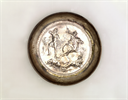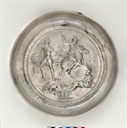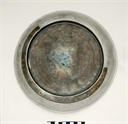Description
The deluxe tableware of late antiquity tended toward conservatism, both stylistically and in terms of content. Elite and aristocratic taste in silverware favored the flowing drapery, organic movement, and informal, asymmetrical compositions that had characterized art in ancient Greece and Rome. All of these qualities, present on this plate, may be contrasted to the developing hieratic style of ecclesiastical silver (for example see BZ.1924.5). As for the content, the subject of the hunt had been a favorite for luxury goods, because hunting was the sport of aristocrats and rulers. The continued use of the theme in the early Christian period drew the scorn of the zealous. The classicizing lion and leopard hunt on this piece is suggestive of the growing gap between Christian and traditional culture at this time.
Even more suggestive is the fact that the mounted hunter is female. Because women were not, as a rule, involved in hunting, the huntress was probably intended to be legendary: either an Amazon, one of the mythical race of warrior women, or Artemis, the Greek goddess of the hunt, whose shrine at Ephesos seems to have remained active into the fifth century. Her presence on this plate should not, however, be understood as an indication of the religious sympathies of its owners. The inhabitants of Mount Olympos continued to decorate luxury objects for centuries after the empire’s official adoption of Christianity. Even though the church fathers of the fourth and fifth centuries railed against the idiocy and depravity of ancient mythology, gods and goddesses persisted in Christian culture, rehabilitated as badges of erudition and as moral allegories. Artemis, who had punished Actaeon for spying on her at her bath, came to be considered an exemplar of modesty and chastity.
- J. Hanson
Bibliography
The Dark Ages; Loan Exhibition of Pagan and Christian Art in the Latin West and Byzantine East, exhibition catalogue, Worcester Art Museum, February 20-March 21, 1937 (Worcester, Mass., 1937), 34, no. 72.
Walters Art Gallery, Early Christian and Byzantine Art, ed. D.E. Miner, exhibition catalogue, Baltimore Museum of Art, April 25-June 22, 1947(Baltimore, 1947), 83, no. 373.
"Dumbarton Oaks Research Library and Collection--Aquisitions December 1, 1946-November 1, 1947," Bulletin of the Fogg Museum of Art 10.6 (1947): 219-39, esp. 225.
The Dumbarton Oaks Collection, Harvard University (Washington, D.C., 1955), 54, 59, no. 125.
M. C. Ross, Metalwork, Ceramics, Glass, Glyptics, Painting, Catalogue of the Byzantine and Early Mediaeval Antiquities in the Dumbarton Oaks Collection 1 (Washington, D.C., 1962), 3-4, no. 4, pl. 2, 3.
Handbook of the Byzantine Collection (Washington, D.C., 1967), 15, no. 55.
M. B. Comstock, C. C. Vermeule, and S. K. Morgan, Romans and Barbarians, exhibition catalogue, Museum of Fine Arts Boston, (Boston, 1976), 179-180, no. 203.
R. Bruce-Mitford and M. Bimson, The Sutton Hoo Ship-Burial, vol. 3 Late Roman and Byzantine Silver, Hanging-Bowls, Drinking Vessels, Cauldrons and Other Containers, Textiles, the Lyre, Pottery Bottle and Other Items (London, 1983) vol. 3.1, 61-63.
P. Meyers, "Elemental Compositions of the Sion Treasure and Other Byzantine Silver Objects," in Ecclesiastical Silver Plate in Sixth-Century Byzantium: Papers of the Symposium held May 16-18, 1986, at the Walters Art Gallery, Baltimore, and Dumbarton Oaks, Washington, D.C. ed. S. Boyd and M.M. Mango (Washington, D.C., 1992), 169-75, Sample no. 55, Table 1.
I. Kalavrezou and A. E. Laiou, Byzantine Women and their World, exhibition catalogue, Arthur M. Sackler Museum, (Cambridge and New Haven, 2003), 181, no. 97.
G. Bühl, ed., Dumbarton Oaks: The Collections (Washington, D.C., 2008), 50, pl. p. 51.
Exhibition History
Worcester, MA, Worcester Art Museum, "The Dark Ages," February 20, 1937 - March 21, 1937.
Baltimore, MD, Baltimore Museum of Art, "Early Christian and Byzantine Art," April 25, 1947 - June 22, 1947.
Boston, MA, Museum of Fine Arts, "Romans and Barbarians," December 16, 1976 - February 27, 1977.
Cambridge, MA, Arthur M. Sackler Museum, "Byzantine Women and Their World," October 26, 2002 - April 28, 2003.
Washington, DC, Freer Gallery of Art & the Arthur M. Sackler Gallery, Smithsonian Institution, “Ancient and Medieval Metalwork from Dumbarton Oaks,” December 16, 2005 – April 1, 2007.
Washington, DC. Dumbarton Oaks, "Woven Interiors: Furnishing Early Medieval Europe," August 31, 2019 - January 5, 2020.
Getty Villa, "Persia: Ancient Iran and the Classical World," April 6, 2022 - August 8, 2022.
Worcester, MA. The Iris and B. Gerald Cantor Art Gallery at the College of the Holy Cross, Bringing the Holy Land Home: The Crusades, Chertsey Abbey, and the Reconstruction of a Medieval Masterpiece, January 26, 2023 - April 6, 2023.










